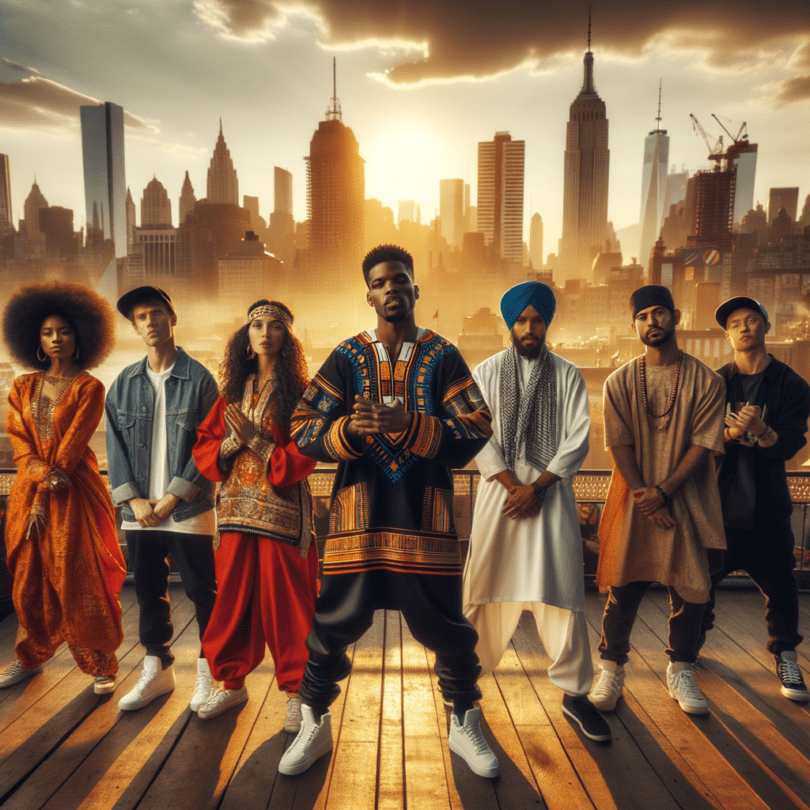So right after “Rapper’s Delight” hit the scene in the fall of 1979, it wasn’t long before people started creating their own versions all over the globe. Brazil got creative with two Portuguese takes, “Bons Tempos” and “Melô Do Tagarela.” Meanwhile, Jamaica brought its flavor with one version sticking close to the original, and another, “Hotter Reggae Music,” turned it into a reggae track. In Europe and beyond, folks were making their own spins: the Netherlands had “Hallo, Hallo, Hallo,” Venezuela came out with “La Cotorra Criolla,” and Germany gave us “Rapper’s Deutsch.”
Within a few years, the song’s essence was popping up in all kinds of ways, like in Japan where Yellow Magic Orchestra put out “Rap Phenomena” in ’81, or in Nigeria with Dizzy K. Falola’s “Saturday Night Raps” by ’82. Even in France with Chagrin d’amour’s “Chacun fait (c’qui lui plaît),” and the Soviet Union saw “Rap” by Chas Pik in ’84. This rapid spread of “Rapper’s Delight” was a huge moment for hip-hop, marking the genre’s first steps into becoming a worldwide sensation. It wasn’t just about rap; it was a whole culture embracing deejaying, break-dancing, and graffiti art.
The next big wave came pretty fast. In France, by 1984, DJ Sidney was hosting “H.I.P.H.O.P.,” which was the first-ever weekly TV show about rap, beating “Yo! MTV Raps” in the U.S. by four years. Come the ’90s, the French scene was buzzing, producing stars like MC Solaar who made it big beyond French borders. France has even become the second-largest rap market globally.
By the turn of the millennium, everyone was buzzing about “global hip-hop.” New styles took root influenced by hip-hop’s reach, like London’s grime, which crafted its own distinct vibe. However, this global expansion of hip-hop comes with a bit of a twist. It’s a genre born from Black American cities, deeply tied to that cultural fabric. On the flip side, one of hip-hop’s core principles is representing local experiences. So, when hip-hop crosses borders, is there a trade-off?
As an ethnomusicologist, I find this question of identity and authenticity fascinating. How do different cultures adopt and adapt outside influences, and in the process, how do they forge their markers of authenticity? With hip-hop, it’s helpful to think of a big range of what could be “authentic,” from echoing Black American styles to drawing deeply from local traditions and languages.
Hip-hop scholar Halifu Osumare talked about authenticity through “connective marginalities,” which basically looks at how different cultures, especially parts of the African diaspora or those shaped by social struggles, can connect through hip-hop. But really, anyone on the outside looking in could relate to hip-hop’s spirit, like Ukraine’s Alyonna Alyonna, who faced bullying, even extending as oddly as Nordic white supremacists.
Yvonne Bynoe, another hip-hop scholar, had a different take. She argued back in 2002 that while rap might go global, hip-hop as a culture can’t really separate from its roots, centered on Black American experiences. Using rap globally makes sense, but to expect hip-hop culture itself to be fully globalized doesn’t.
The documentary “Hip Hop Colony” about Kenyan hip-hop discussed how hip-hop could initially seem like a new kind of colonization, influencing everything from language to lifestyle. But the film flips this idea by showing Kenyans making hip-hop uniquely theirs. Hip-hop, wherever it lands, often acts as a spark for self-reflection and cultural revival.
Senegalese rapper Faada Freddy noticed the similarity between hip-hop and a local art form, taasu, saying it felt familiar because rhyming and rhythm were already part of their tradition. In Australia, Wire MC saw hip-hop aligning with Indigenous cultural gatherings called corroborees, saying hip-hop is a modern version of storytelling through singing and dancing.
Native American rapper Frank Waln saw a connection between hip-hop and Lakota storytelling, putting it simply as a new way to tell age-old stories. No matter where rap and hip-hop have traveled, people resonate with it by linking it back to their own traditions, sometimes melding them into something new, like Japanese rapper Hime using tanka poetry, or Ghana’s Obrafour weaving in local proverbs.
In France, historical ties between rap and traditional French song have been explored, especially by artists like Abd al Malik, reflecting his experience as part of the African diaspora there. The close ties between hip-hop and Black American culture continue to be essential as hip-hop evolves worldwide. Take China’s Vava, for instance, who believes hip-hop gives young Chinese a voice for rebellion today.
The idea of authentically spreading hip-hop, as linguist Alastair Pennycook described it, has been a talking point ever since “Rapper’s Delight” opened those global doors. Afrika Bambaataa, a pioneering DJ, once advised French artists to stay true to their language and experiences when creating rap.
Jay-Z, in his 2010 memoir “Decoded,” touched on this too, noting that rap—much like any art—originates from specific experiences but speaks to universal themes. The journey of hip-hop is like hearing stories from MCs around the world, each using it to navigate their realities and ours.

